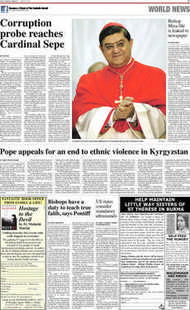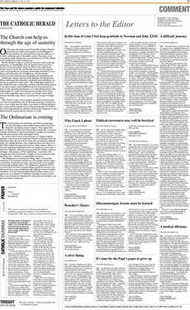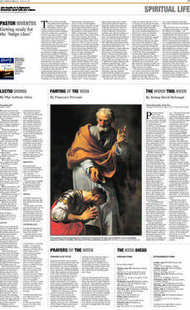Page 15, 25th June 2010
Page 15

Report an error
Noticed an error on this page?If you've noticed an error in this article please click here to report it.
Tags
Share
Related articles
Spiritual Books
Harry Potter Hacker Claims Papal Inspiration
Post-christian Spiritual Combat
The Use Of " Father"
The Truth About Harry Potter
SPIRITUAL BOOKS FRANCIS PHILLIPS
Harry Potter and the Paganization of Culture by Michael O’Brien, Fides et Traditio, £16.99 Michael O’Brien, wellknown Canadian icon painter and novelist, has written this serious reflection on the Harry Potter phenomenon. It is a brave exercise, well worth reading, if only to make readers think harder about a subject they would rather not engage with.
On the one hand, there is a global army of Rowling supporters, glad that their children are reading anything, and convinced that the seven books of the series are imaginative, harmless fun; on the other is a Bible Belt backlash, which regards the series as dangerous occult literature. Into this fiercely polarised argument comes O’Brien’s own measured voice.
In his preface the author points out that “we are living in a vast, multidimensional war zone, a good deal of which is invisible to our eyes”. I think no writer on spiritual themes would disagree with this. Again, O’Brien reminds us that the development of a moral imagination “demands selfrestraint”, ie that intellectual freedom for a Christian is different from the haphazard morality displayed by secular writers. His fundamental charge against Rowling concerns her use of symbolism: “We must never lose sight of the truth that symbols are among the most potent of human languages,” he says. What Rowling does is to mix together good and toxic symbols, setting up confusion for young readers; consciously they know it is all make-believe “but on the subconscious level they have absorbed it as experience”.
What is dangerous is this hybrid quality of the stories; they combine heroic elements with antiheroic elements – often employing evil means to overcome evil on the grounds that the end justifies the means. O’Brien acknowledges that the books provide an intoxicating mixture of excitement, imaginative display and ingenuity but makes the analogy with junk food: addictive to eat but providing no substantial nourishment.
Why is Rowling so different from Tolkien or C S Lewis, the author’s critics might ask. O’Brien, who is steeped in children’s fantasy literature and who has written an earlier book, Landscape with Dragons, about the importance of the “baptised imagination”, suggests that these authors “knew that witchcraft and sorcery were powerful, always treacherous and often deadly”.
The problem is not the presence of magic in children’s literature, but how this magic is presented. Is its use faithful to the moral order of the universe or not? If not, how does this adversely affect children?
O’Brien would agree that for children brought up within a strong Christian moral framework, and whose reading diet includes Narnia and The Lord of the Rings, the risks of reading Rowling are negligible.
But almost all her youthful readers have no imaginative boundaries at all; thus the demonstration of magical or supernatural powers will not underline their childish understanding of the power that belongs to God alone; it will strengthen a subconscious acceptance of a wholly pagan world, where good is often compromised and weakened and where there is no appeal to an ultimate wise authority.
The author makes perceptive comparisons between Harry Potter and Frodo and between Gandalf and Professor Dumbledore. He also discusses other modern potent examples of the genre, such as the Philip Pullman trilogy and the Twilight series of Stephanie Meyer. Quoting the critic Russell Kirk, he points out that when culture is deprived of an authentic moral vision, there is a resulting rise of the “diabolic imagination”.
Friendship with Jesus by Amy Wellborn and Anne Engelhart, CTS, £9.95 Subtitled Pope Benedict XVI speaks to children on their First Holy Communion this beautifully illustrated book casts its own “magic” on the above debate. The questions are artlessly direct and the Pope’s responses both simple and profound. For example, “Anna” asks him to explain what Jesus meant when he said: “I am the bread of life.” Benedict replies: “It means that Jesus himself is the nourishment we need for our soul, for our inner self, because the soul also needs food. In other words, Jesus nourishes us so that we can truly become mature people and our lives become good.” No one would advocate turning children’s fantasy fiction into a moral tract. But, just as the soul requires life-giving food, so do children’s minds and hearts; the question is: can a pagan, unbaptised imagination provide it?
blog comments powered by Disqus





















